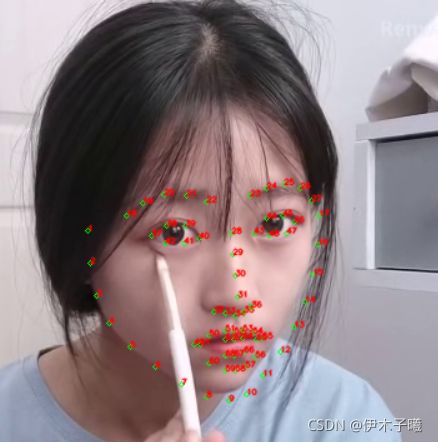python3+opencv3.4+dlib库(人脸识别)
目录
- 一、python3.7 下 dlib 的配置
- 二、人脸检测 + 标注
- 三、人脸检测(戴墨镜)
- 四、参考
一、python3.7 下 dlib 的配置
-
安装dlib
注意:直接输入安装dlib可能会出错,因为可能最新版无whl格式的安装包
由于在安装python版本的opencv支持库回遇到版本以及32位64位的问题,需要自己去寻找python版本的.whl下载.下面的地址是各种whl网址
https://www.lfd.uci.edu/~gohlke/pythonlibs/
也可通过以下方式(python3.7或3.8)
链接:https://pan.baidu.com/s/1Fm1W_Os8Dz1TpiFB8nXcsg
提取码:0614
2. dlib中为我们提供了关于人脸检测标注训练好的文件可在http://dlib.net/files/shape_predictor_68_face_landmarks.dat.bz2下载
(下载完成后解压到工程目录下)
二、人脸检测 + 标注
-
利用Dlib官方训练好的模型“shape_predictor_68_face_landmarks.dat”进行68点标定,利用OpenCv进行图像化处理,在人脸上画出68个点,并标明序号;
如图:

-
获取特征数据集将写入csv。
# -*- coding: utf-8 -*-
# 人脸标出68个点
"""
Created on Wed Oct 27 03:15:10 2021
@author: GT72VR
"""
import numpy as np
import cv2
import dlib
import os
import sys
import random
# 存储位置
output_dir = './dataset/faces'
size = 64
if not os.path.exists(output_dir):
os.makedirs(output_dir)
# 改变图片的亮度与对比度
def relight(img, light=1, bias=0):
w = img.shape[1]
h = img.shape[0]
#image = []
for i in range(0,w):
for j in range(0,h):
for c in range(3):
tmp = int(img[j,i,c]*light + bias)
if tmp > 255:
tmp = 255
elif tmp < 0:
tmp = 0
img[j,i,c] = tmp
return img
#使用dlib自带的frontal_face_detector作为我们的特征提取器
detector = dlib.get_frontal_face_detector()
# 打开摄像头 参数为输入流,可以为摄像头或视频文件
#camera = cv2.VideoCapture(0)
camera = cv2.VideoCapture('./dataset/video/wanwan.mp4')
ok = True
detector = dlib.get_frontal_face_detector()
predictor = dlib.shape_predictor('./file/shape_predictor_68_face_landmarks.dat')
while ok:
# 读取摄像头中的图像,ok为是否读取成功的判断参数
ok, img = camera.read()
# 转换成灰度图像
img_gray = cv2.cvtColor(img, cv2.COLOR_BGR2GRAY)
rects = detector(img_gray, 0)
for i in range(len(rects)):
landmarks = np.matrix([[p.x, p.y] for p in predictor(img,rects[i]).parts()])
for idx, point in enumerate(landmarks):
# 68点的坐标
pos = (point[0, 0], point[0, 1])
print(idx,pos)
# 利用cv2.circle给每个特征点画一个圈,共68个
cv2.circle(img, pos, 2, color=(0, 255, 0))
# 利用cv2.putText输出1-68
font = cv2.FONT_HERSHEY_SIMPLEX
cv2.putText(img, str(idx+1), pos, font, 0.2, (0, 0, 255), 1,cv2.LINE_AA)
cv2.imshow('video', img)
k = cv2.waitKey(1)
if k == 27: # press 'ESC' to quit
break
camera.release()
cv2.destroyAllWindows()
三、人脸检测(戴墨镜)
1.代码只是对上面的代码稍加改动添加
代码:
# -*- coding: utf-8 -*-
"""
Created on Wed Oct 27 03:15:10 2021
@author: GT72VR
"""
# -----画眼镜-----
import numpy as np
import cv2
import dlib
import os
import sys
import random
# 存储位置
output_dir = './dataset/faces'
size = 64
if not os.path.exists(output_dir):
os.makedirs(output_dir)
# 改变图片的亮度与对比度
def relight(img, light=1, bias=0):
w = img.shape[1]
h = img.shape[0]
# image = []
for i in range(0, w):
for j in range(0, h):
for c in range(3):
tmp = int(img[j, i, c] * light + bias)
if tmp > 255:
tmp = 255
elif tmp < 0:
tmp = 0
img[j, i, c] = tmp
return img
# 使用dlib自带的frontal_face_detector作为我们的特征提取器
detector = dlib.get_frontal_face_detector()
# 打开摄像头 参数为输入流,可以为摄像头或视频文件
# camera = cv2.VideoCapture(0)
camera = cv2.VideoCapture('./dataset/video/congming.mp4')
ok = True
detector = dlib.get_frontal_face_detector()
predictor = dlib.shape_predictor('./file/shape_predictor_68_face_landmarks.dat')
while ok:
# 读取摄像头中的图像,ok为是否读取成功的判断参数
ok, img = camera.read()
# 转换成灰度图像
img_gray = cv2.cvtColor(img, cv2.COLOR_BGR2GRAY)
rects = detector(img_gray, 0)
for i in range(len(rects)):
landmarks = np.matrix([[p.x, p.y] for p in predictor(img, rects[i]).parts()])
for idx, point in enumerate(landmarks):
# 68点的坐标
pos = (point[0, 0], point[0, 1])
print(idx, pos)
# 利用cv2.circle给画眼镜,
if idx in range(37, 48):
cv2.circle(img, pos, 10, (0, 0, 0), -1)
# 利用cv2.putText输出1-68
font = cv2.FONT_HERSHEY_SIMPLEX
if idx == 37:
pos_s1 = (point[0, 0], point[0, 1])
elif idx == 38:
pos_s2 = (point[0, 0], point[0, 1])
size = (pow(pow(pos_s2[1] - pos_s1[1], 2) + pow(pos_s2[0] - pos_s1[0], 2), 0.5))
elif idx == 39:
pos_1 = (point[0, 0], point[0, 1])
elif idx == 42:
pos_2 = (point[0, 0], point[0, 1])
elif idx == 41 or idx == 46:
cv2.circle(img, pos, int(3 * size), (0, 0, 0), -1)
if idx > 42:
cv2.line(img, pos_1, pos_2, (0, 0, 0), 4)
cv2.imshow('video', img)
k = cv2.waitKey(1)
if k == 27: # press 'ESC' to quit
break
camera.release()
cv2.destroyAllWindows()
四、参考
Python+OpenCV的人脸识别实现带墨镜效果
https://cungudafa.blog.csdn.net/article/details/93493229

